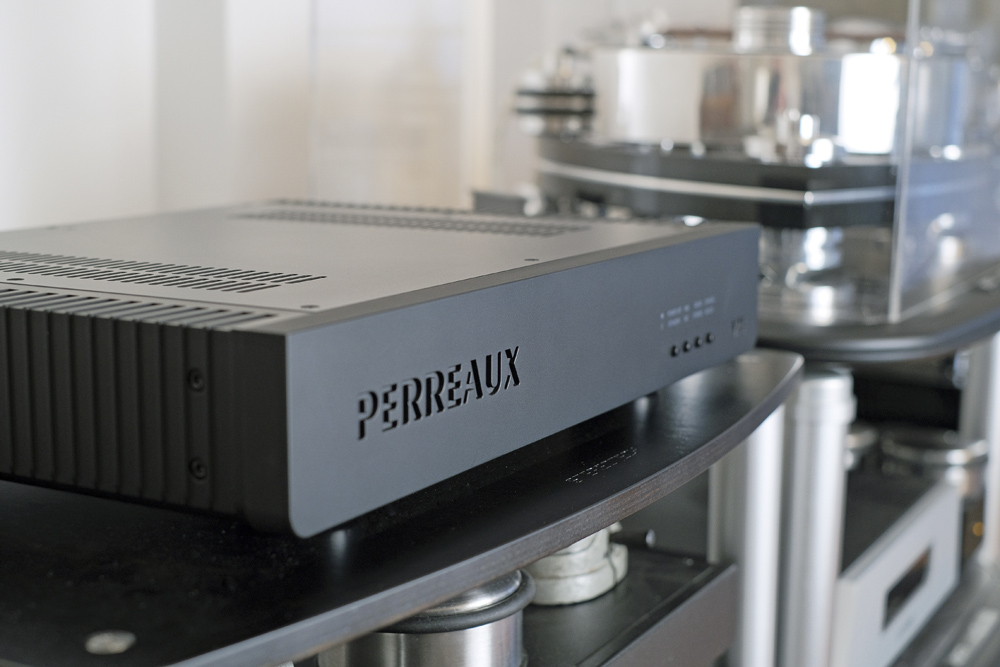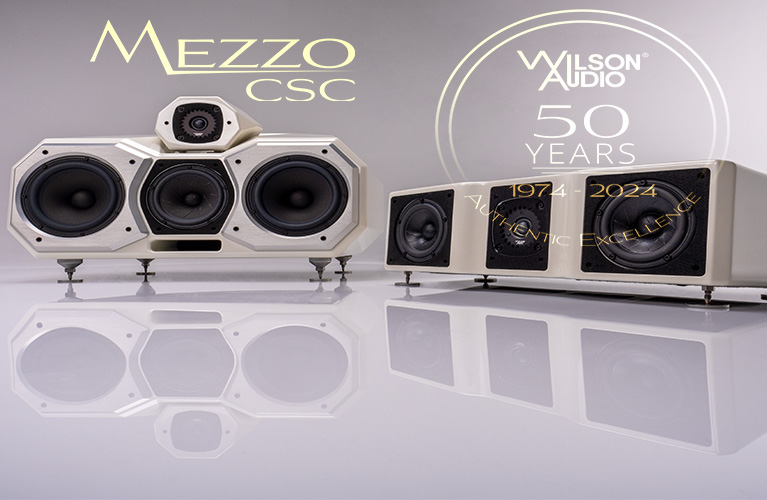Today, in a digital age no less, the turntable enjoys an arguably stronger market presence than ever among audio enthusiasts. Based on just product choice too, let alone materials and technology developments. Yet, as we know, the turntable is a part of an analogue playback system. It requires a set of supporting ancillaries. To fill that requirement, there are a plethora of tonearm, cartridge, and phono cabling choices. Heck, there’s even an embarrassment of options for just pucks, dust brushes, and other accessories/tweaks. Yet, once the TT’s support team is assembled, the final component of necessity, the music delivery conduit, is the phono preamplifier. For the most part, the ‘Phono Stage’ has seen little change in decades. Until now. I’m looking at Perreaux Audio’s VP4, the company’s newest, and one which truly differentiates itself from the vast majority of its competitors. How? Well, by offering innovative features – perhaps even unique – elevating it above the maddening crowds. VP4 is a phono stage intelligently engineered for 21st century analogue playback.
Back in Black
So, yeah, what’s so different with the VP4? In my opinion, Perreaux Audio has launched a ‘Phono Preamplifier’ far removed from formulaic cookie cutter me-too-ishness, provocatively throwing the gauntlet at the upmarket phono stage space. OK, yes, it’s a black box, in defiant contrast to the flashily delightful colours the company offers for other components, like the extroverted Perreaux iX200 integrated amplifier to name one (reviewed here in purple). But there’s a tongue-in-cheek reason why it’s a black mass.
One of the less common features of the VP4, but not unique, is that it features a built-in battery pack. When the battery is active, Perreaux calls that form of operation ‘BLACK Mode’, and it’s claimed to provide the, umm… blackest background possible from vinyl playback. So, you’ve spotted the tie-in by now, right. BLACK AC immunity, black backgrounds and a deep, dark, black hole matt chassis.
While there are some battery-powered phono stages on the market, the VP4 differentiates itself from most phono stages out there by being fully configurable via a bespoke app available for both Android and iOS. As far as I know, you can count phono stages with that feature set in one Red Right Hand… with missing fingers. So, your cartridge’s parameters can be adjusted via the app on the fly. No chassis top removing, no tiny-dip-switch fiddles, no guess work regarding adjustment changes and their sonic effects. Just listen and set on the go in real time. Cliché drop number one: VP4 is a ‘Game Changer’.
I’ll describe the facilities available on the app anon but, for now, I’ll talk about the connectivity options offered on the unit’s rear panel. There’s a main on/off switch (which works in tandem with the front panel’s switch for mains or BLACK Mode) above a 9-pin RS232 D-Type connector, with safety screws, which accepts the small power supply bubble pack. The VP4 can be operated via the power supply or in BLACK Mode, with the power supply also serving to charge the battery, of course.
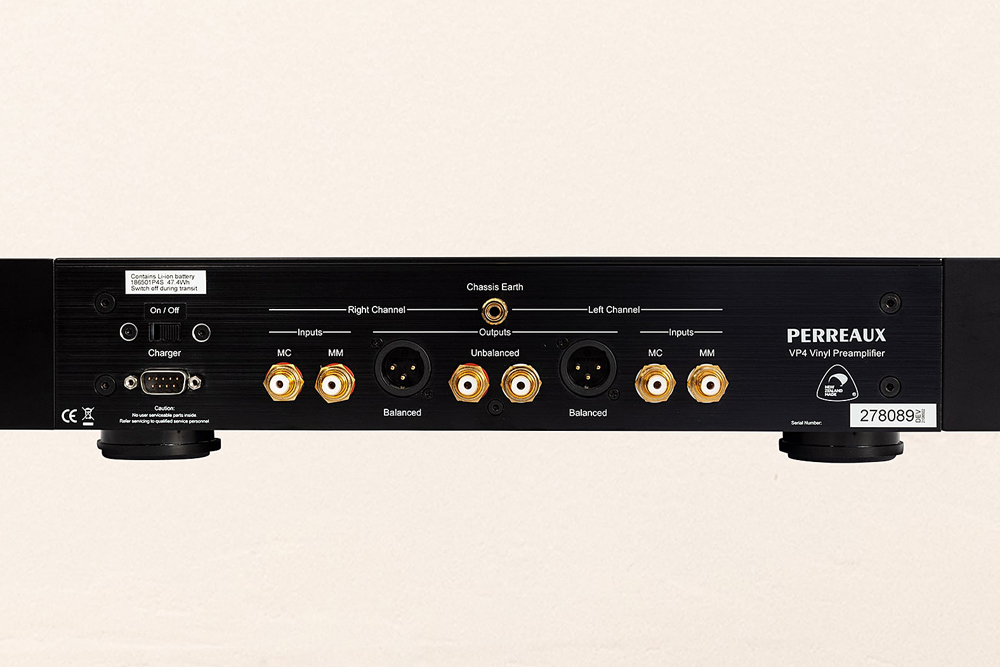
At the top and centre of the panel is a gold plated ground post. Below that you’ll find good quality, independent RCA input sockets for Moving Magnet (MM) and Moving Coil (MC) cartridges split between left/right channels. The MM input can be configured via the app to be set up as a second low-output MC input. So that means that two turntables can be connected at the one time with a mix of MM and MC cartridges or one high-output and one low-output MC. The output bank features both balanced XLR and unbalanced RCA connectors. That’s it. All else is controlled via the app. A set of small buttons on the VP4’s fascia (in case you you’re from the Stone Age and don’t use a smartphone or tablet) controls a limited selection of functions such as power on/off, switching between MM/MC, mono and stereo playback, and selection of ‘Charge’ or ‘BLACK Mode’ operation.
All the switching configurations, whether set by the app or the physical buttons on the front panel, are relay-based. Aside from the benefits in terms of lower noise, according to Perreaux, the use of high quality relays allows for an optimised PCB circuit layout. Call me quirky but I actually enjoyed hearing the rapid click, click, click of the relays as they jumped about switching settings.
The in-built battery – or power cell – is a Li-ion 3.2Ah type. It comes into play when the VP4 is set to BLACK Mode which then provides “Total Galvanic Isolation” and noise immunity from electronic circuitry and AC. No AC ground loop possibility either, something that can creep up in some systems. The battery is quoted as providing up to 30 hours of playback operation when fully charged. Perreaux also states the battery itself is of “the highest quality”, has a very low impedance of approximately 150 milliohms, and can provide stable supply under varying loads.
Now, to that wonderful app (version 2.1.18 at the time of writing with firmware V12). I must state at the outset that the app paired (Bluetooth) to the VP4 almost immediately and performed trouble free throughout its stay at SoundStage! Australia HQ. Once paired, you open the app and select, via the Perreaux company logo, to control either the VP4 or iX200/iX300 components. Once the VP4 is selected, the screen shows a variety of setup options and status data. There’s a power switch, a VP4 battery level indicator, and a Bluetooth pairing icon (in red or green for obvious reasons). In a set of horizontal sections, you’ll see options to activate Charge, setup for Mono/Stereo, and to select between IEC RIAA or standard RIAA curves. The last section opts between MM and MC cartridges.
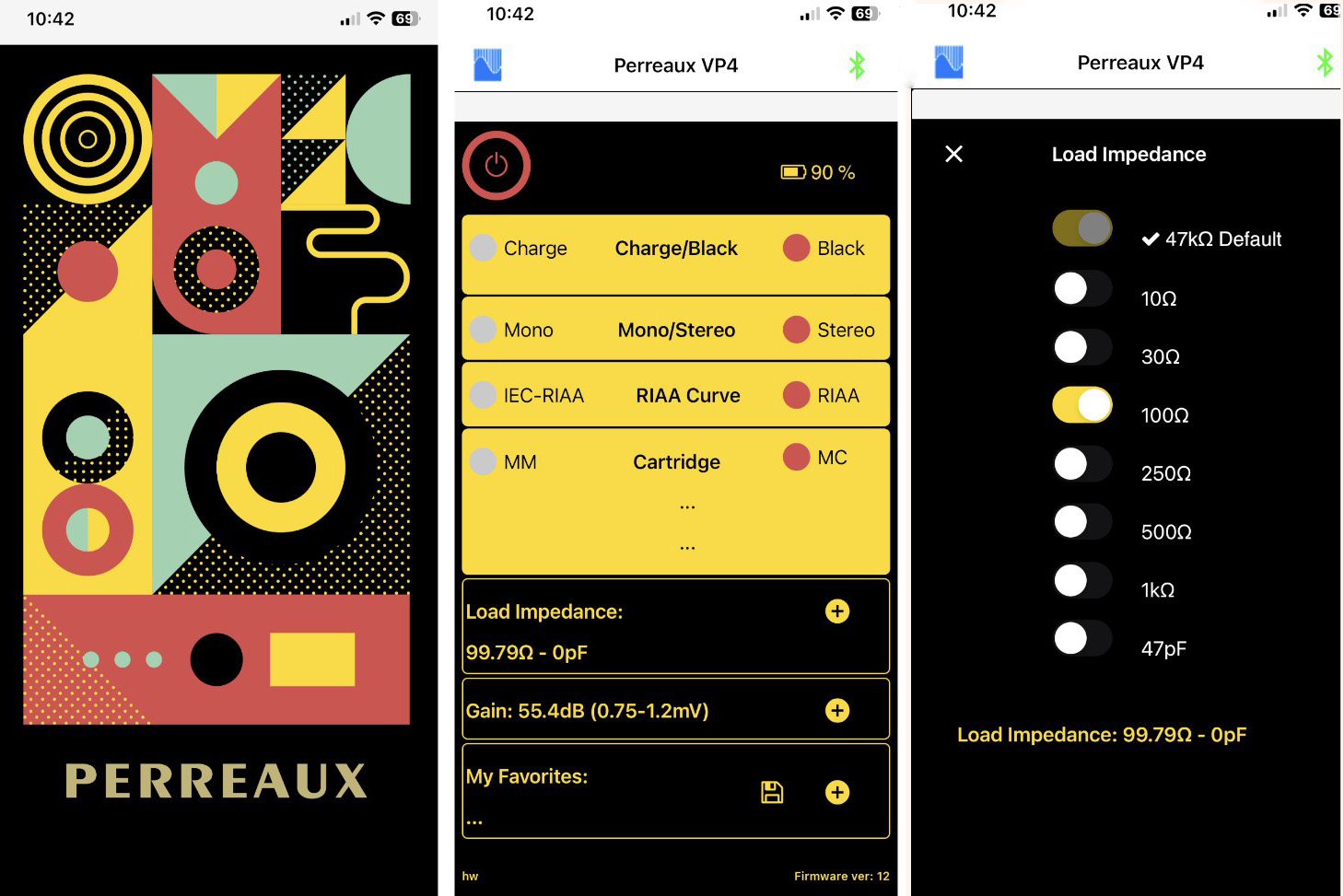
Below those segments, there are the specifications settings related to the cartridge/s in use. The Load Impedance settings have a 47 kohms default and then selections for 10, 30, 100, 250, 500 ohms, 1 kohms, 47pF. Below that there are the VP4’s Gain settings at 55.4dB, 59.5dB, 60.9dB, 63.3dB, 65.4dB, 66.1dB and 67.5dB. Finally, a ‘Favourites’ option allows the user to save and store up to 10 custom setups which can be individually named and switched on the go. Perreaux also offers via the app a database of popular cartridges which allows quick one-touch setup, with the list being relatively comprehensive and, I assume, will continue to expand (however, my much-loved Shelter Harmony was not listed in the database). So, overall, a comprehensive set of fine-tuning choices which are concrete evidence of a very versatile phono stage. Kudos.
The VP4’s output impedance is quoted as 30 ohms balanced and 100 ohms unbalanced while its maximum output is 4.6 Vrms. Perreaux states the RIAA accuracy at +/- 0.5dB from 50 Hz to 20 kHz while the unweighted Signal to Noise Ratio (SNR) are 87dB for Moving Magnet and 82dB for Moving Coil. Total Harmonic Distortion (THD) is given as a low 0.002% at 1 kHz at rated output. Circuit and component noise is minimised and channel separation maximised by the internal mirrored layout.
The VP4’s build quality overall is solid while its styling is understated. There’s a monolithic feel to the VP4, it’s an almost featureless deep black chassis with faux lateral heatsinks. Its matt textured fascia features a deep, stylistic etching of the company name. VP4 weighs in at a reassuring 5.3kg.
The New Black
Once hooked-up and powered, I charged the VP4 up to about 95% level. Then, I setup the various gain and impedance settings and saved those as a favourite preset, which I then called ‘Shelter Harmony’. The exercise to set the cartridge via the app took less than 10 minutes, and that included download of the app onto my iPhone 12Pro first (I upgraded to iPhone 15 Plus halfway through my time with VP4 and, again, zero issues). Perreaux also provided a Samsung Android-based phone for testing purposes. Both Operating Systems worked flawlessly.
Hey, now I know what Black means. It means silence between notes. It means startling transient velocity and a startling separation of instrumental threads. It means only the music.
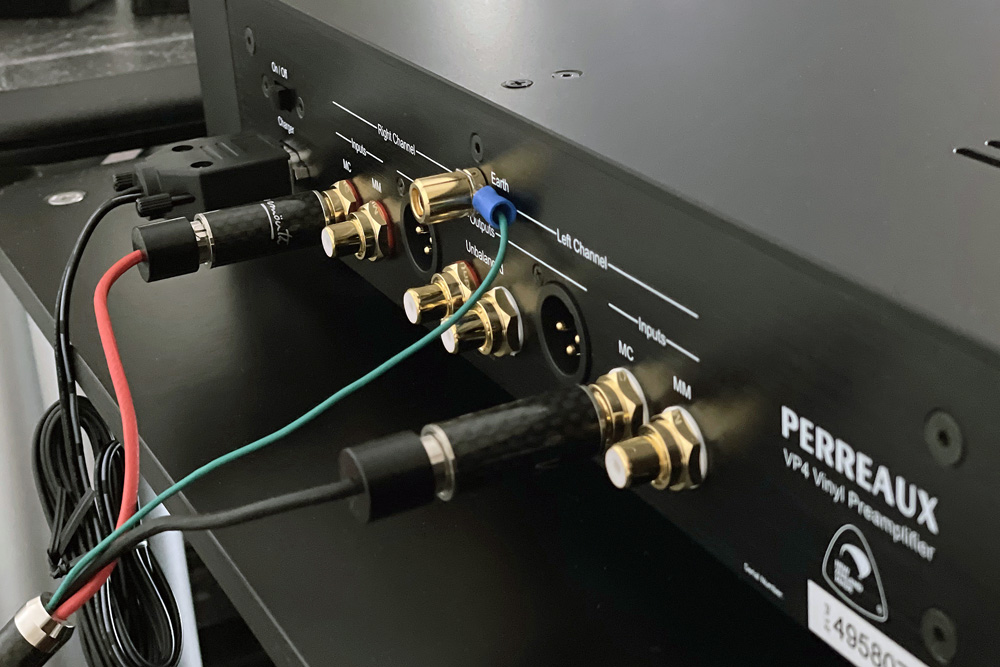
Provided all is as it should be regarding cartridge setup, etc., if there’s info in the grooves to be gotten, the VP4 will grab it and present it to the listener on a black metal tray. The subtleties of Gold Note’s beautifully produced Carillon (Limited Edition number 403 of only 500 and edited from the original master tape) by the Ensemble Operarmonica was such a pleasure to listen to. There was nuance and rich tonal textures presented in a fluid way which are signature super-powers of truly great vinyl. The interplay between the instrumentalists projected clearly and with excellent delineation. There was a satisfying dynamic shading between the flute, piano and soprano.
Realistic vocal presence is always a staple of good analogue, as I’ve found with my turntable rig, comprising the abovementioned Shelter Harmony on the superb Reed 1X tonearm which, in turn, is mounted to the delightful Transrotor Crescendo Black turntable. In my system, the signal then flows to my Supratek Cortese’s excellent in-built phono stage or the Redgum Audio RGPH2 Reference phono stage. Via the VP4, the three ladies’ vocals on Trio Palabras’ Lo Que Dice Mi Cantar album (from the excellent Muxía Music label) presented an immediate sound with astounding realism and terrific separation between voices, the widespread percussion, and the rest of the backing band’s instrumentation. Particularly good was the acoustic guitar and ancillary percussive Latino instruments. It’s a slightly more forward perspective than via the Supratek, yet equally pleasing and one that pays off big time when spinning Rock tracks.
So, here we go then with some heavier fare. Iggy Pop’s “Cry For Love” from his Blah, Blah, Blah punched with rewarding heft. Iggy’s deep vocals were well rendered with their proper depth and tonality – I know the singer’s voice well from several of his releases, this vinyl aside, from my CD and streaming library. To be able to clearly hear the handclaps, which are intercut through sections of the track over and above the sonic mayhem of guitars, drums and Iggy’s voice, is quite the achievement for any phono stage. Especially considering this is a mainstream rock recording. There’s also a solid sense of pace to the music, the transient attack from the electric bass and the drum kit – whether kick drum, tom or snare – is sharply rendered and quite well separated. They same level of precision applied to The Pixies’ “Hey” from the Doolittle album. Here, the tightness of the electric bass and the oomph of the kick drum through the first section of the track are solidly rendered with excellent detail and percussive punch.
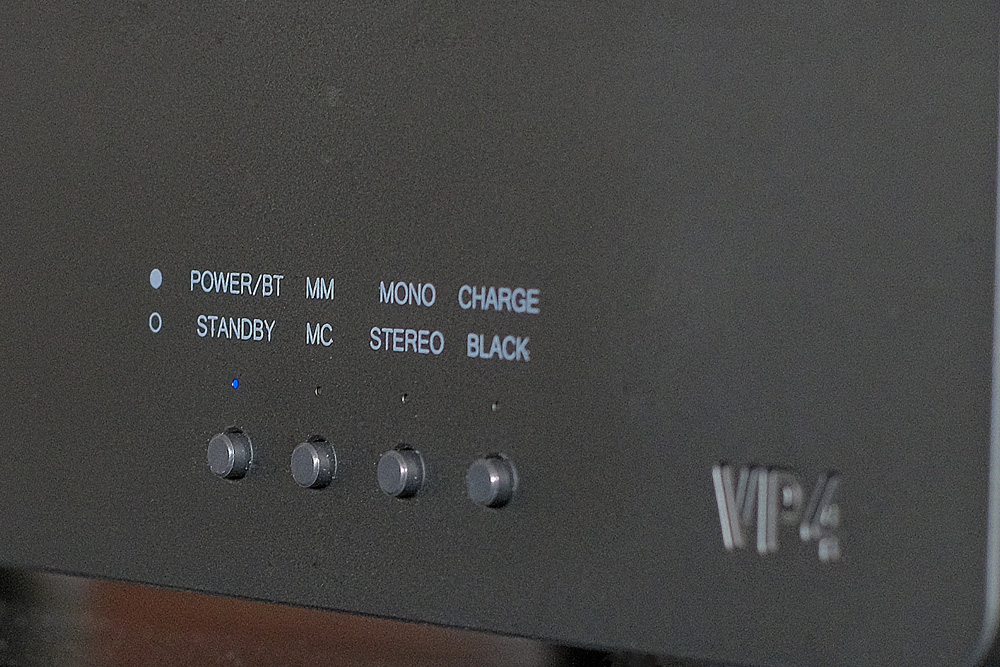
Equal power and grandeur were displayed through the various orchestral works I spun. I have a large collection of Deutsche Grammophon German pressings, many of which are from iconic orchestra performances guided by von Karajan, Rostropovich, Abbado and other luminary conductors. The VP4 presented these marvellous recordings with the openness, spaciousness and the glory they deserve. The delicacy of Mozart’s Konzert für Klavier und Orchester Nr. 17 G-dur KV 453 as played and directed by Géza Anda, with the Camerata Academica des Salzburger Mozarteums, was a true delight. Again, a well-textured tonal signature showcased the piano in an open-wide stage with tremendously deep perspectives and a genuine hall ambience. BLACK Mode’s silence serves to clearly differentiate not just instruments from each other, but also the flow of the individual movements, ebbing and flowing, yet still forming part of an entirety, summing to a musical whole. I lost myself listening to this album, especially through the latter sections of the second track. Wonderful.
Conclusion
So, the VP4 is a phono stage from a company with a long history of quality, ultra-reliable electronics. In fact, Perreaux’s MOS-FET amplifiers from the ‘70s and ‘80s are legendary for their battleship durability under the most stressful of conditions. While the unbreakable reputation stemmed from the company’s Pro Audio products, it nevertheless carried through into the consumer space where audio performance reached equal heights of reputability.
The VP4 is undoubtedly a reflection of Perreaux striving to build that narrative in terms of its sonic performance, while continuing the theme of construction solidity as exhibited by the chassis solidity and connector quality. Yet, the company has combined those tried-and-true ingredients with a twist of modernity which is uncommon in the phono stage space. The VP4’s user experience is solid while the app GUI, accessible via smartphone or tablet, makes the unit a breeze to customise functions and settings.
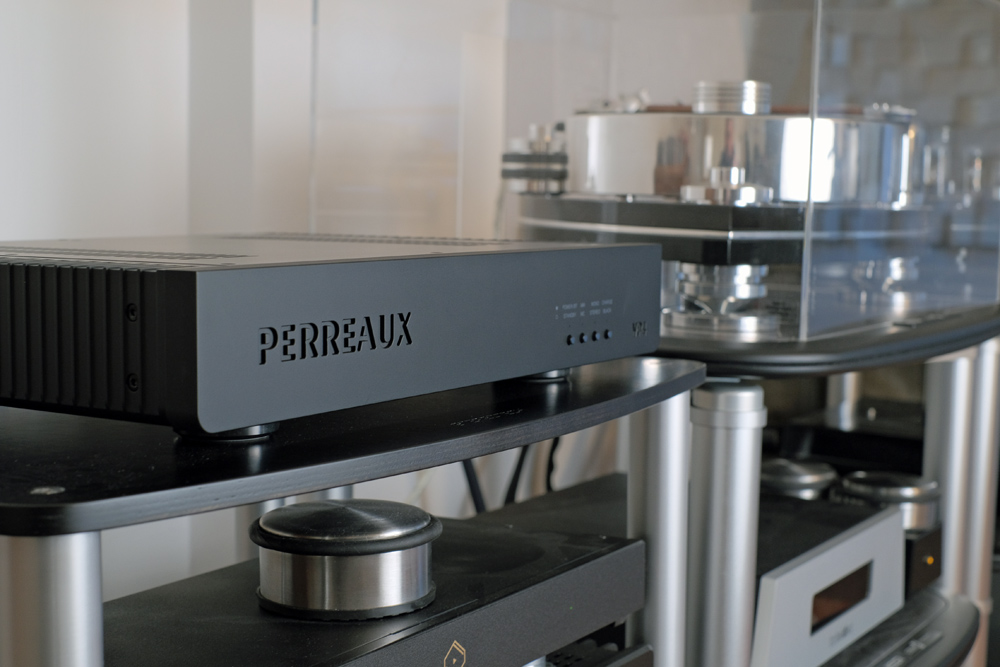
Beyond that excellent user interaction, the VP4 is a good performer, sonically. Its circuitry steps out of the way, allowing a quietly spacious sound. It’s fast and tight across the bandwidth while presenting an immediate sound which delights with vocalists.
As far as its engineering, especially in light of the 21st century user interface and at its price point, Perreaux’s VP4 is a beacon in the analogue space. Will the phono stage competition move with the times and take-up the gauntlet?
… Edgar Kramer
This email address is being protected from spambots. You need JavaScript enabled to view it.
Associated Equipment
- Speakers — Wilson Audio Alexia V, Axis Loudspeakers VoiceBox S (nearfield monitor), Vermouth Audio Little Luccas Mk.II, Atacama stands
- Amplifier — Gryphon Audio Antileon EVO
- Preamplifier — Supratek Cortese, Totaldac d1-triunity (direct to amplifier)
- Sources — Digital: 432 EVO Aeon Mk.3 Reference Music Server/Roon Core, Yamaha CD-S2100 transport, Totaldac d1-triunity DAC. Analogue: Transrotor Crescendo with Konstant Studio controller, Reed 1X Tonearm with upgraded internal wiring, Shelter Harmony cartridge, The Funk Firm Houdini cartridge decoupler, Supratek Cortese & REDGUM Audio RGPH2 phono stages
- Processor — DEQX PreMate (part of arsenal/casual use)
- Cables — VYDA Laboratories Orion Silver Reference HFC IC and speaker cables, PSC Audio custom design XLR, Vermouth Audio Reference loom,ZenSati Zorro, Tubulus Concentus USB
- Audio Rack — SGR Audio Statement Model V, Aspire Audio Belgravia amplifier platform (customised for Gryphon Audio Antileon EVO), Stereotech Aluminar Dark 3-tier rack
- Acoustic Treatment — Vicoustic Multifuser Wood, Wavewood Ultra, Cinema Round Premium and Super Bass Extreme
- Miscellaneous — Silent Angel Bonn N8 Pro network switch, GigaWatt PF-1 EVO power strip, Les Davis Audio Viscoelastic CLD discs, Voodoo Cable Iso-Pods, Bocchino Audio Mecado, VRC Vinyl Record Cleaning system plus miscellaneous accessories
Perreaux Audio VP4 Phono Preamplifier
Price: AU$7490
Australian Warranty: Three Years (Once Registered Online)
Australian Distributor: Sound And Music
+61 (0)422 743 703
audiophile.sound-music.com/
Perreaux Audio
PO Box 305, Mosgiel
Dunedin 9053
New Zealand
+64 3 489 2975
www.perreaux.com






